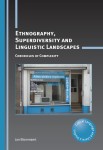This month we published Transcultural Pedagogies for Multilingual Classrooms edited by Rahat Zaidi, Umit Boz and Eve Moreau. In this post Eve discusses how critical multilingual and transcultural pedagogies are used to address the superdiversity in classrooms today.
 Teaching in superdiverse classrooms might be trumpeted as one of the great educational challenges of our times. How students straddle distinct cultural and linguistic worlds to make meaning of curricular content has never been more intricate and complex. With technological innovations and the rapid emergence of accessible media content, teachers and learners can, in a sheer instant, connect with people and places who are far beyond the local providing them with a scope of the world that is unlike anything that has existed in education before. And yet, in our current social climate, the divisions that are constructed along stiff identity markers are reinforcing beliefs about separateness among people and fueling discriminatory and violent behaviors in schools and beyond. New ways to address interconnectedness amongst students’ complex networks of difference has become imperative.
Teaching in superdiverse classrooms might be trumpeted as one of the great educational challenges of our times. How students straddle distinct cultural and linguistic worlds to make meaning of curricular content has never been more intricate and complex. With technological innovations and the rapid emergence of accessible media content, teachers and learners can, in a sheer instant, connect with people and places who are far beyond the local providing them with a scope of the world that is unlike anything that has existed in education before. And yet, in our current social climate, the divisions that are constructed along stiff identity markers are reinforcing beliefs about separateness among people and fueling discriminatory and violent behaviors in schools and beyond. New ways to address interconnectedness amongst students’ complex networks of difference has become imperative.
Transcultural Pedagogies for Multilingual Classrooms: Responding to Changing Realities in Theory and Practice is a timely, cutting-edge collection of research studies from across the globe from some of the top scholars in multilingual and transcultural education. It explores the ways in which transcultural pedagogies can support learning and literacies in critical, creative and socially just ways. By exploring the value of affirming cultural and linguistic fluidity in classroom teaching, the researchers describe hopeful practices that harness the diversities of students as a rich resource for learning and interrelating.
Each chapter provides a different and innovative perspective with respect to reimagining language and literacy pedagogies in conjunction with students’ diverse literacies and resources. Presenting a collection of classroom and community-based research, the book addresses the intersections of plurilingualism, identity and transcultural awareness in various contexts, including schools, universities, as well as local and Indigenous communities. These settings have been deliberately chosen to profile the range of research in the field, showcasing transcultural, plurilingual, translanguaging and community-engaged pedagogies, among others.
Eve Moreau
For more information about this book please see our website.
If you found this interesting, you might also like Languaging Myths and Realities by Qianqian Zhang-Wu.



















